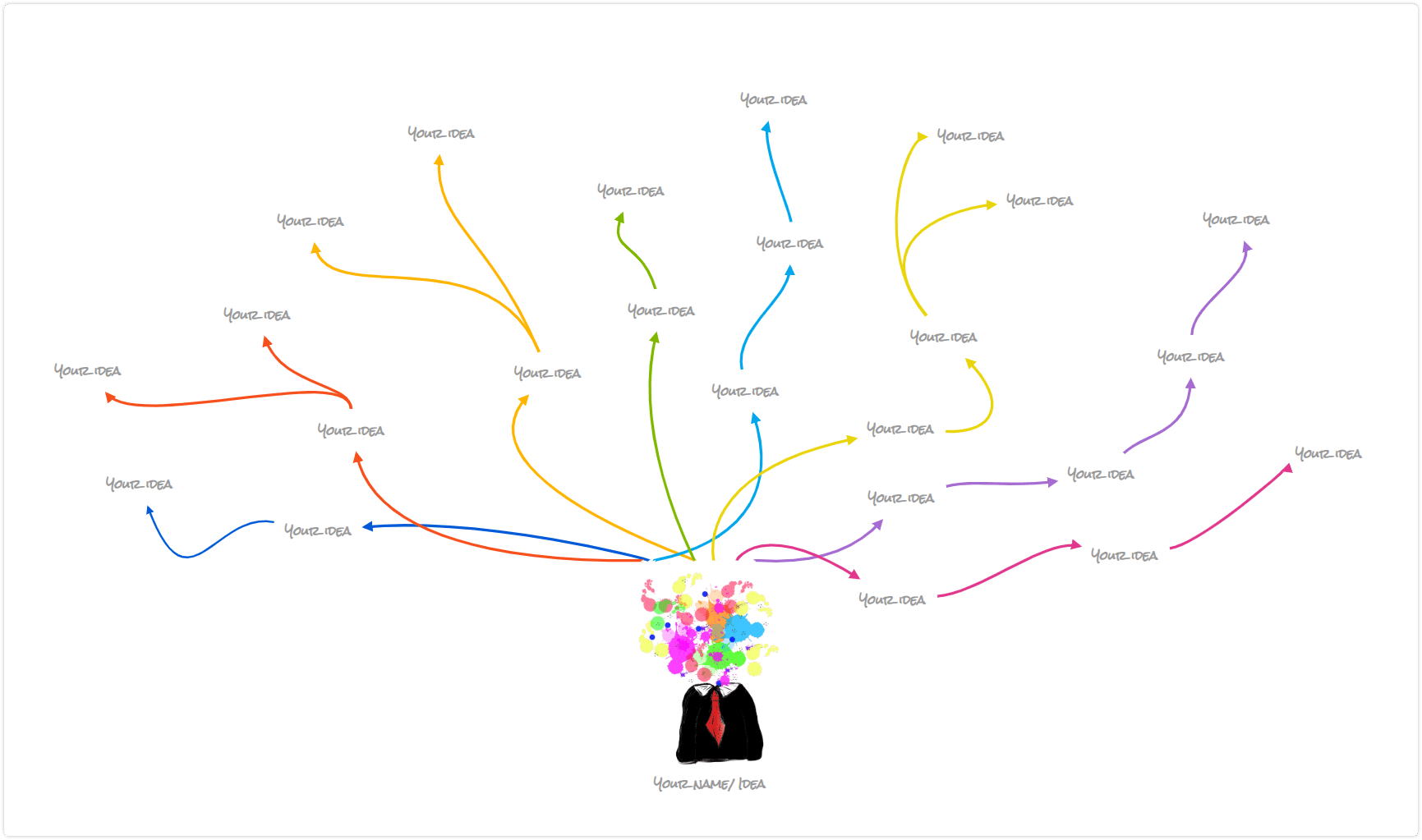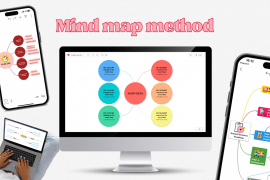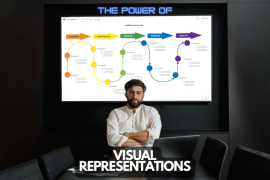
Welcome to a world where creativity is the engine of progress.
The methods we employ to generate and organize ideas aren’t just tools. They’re catalysts. And these catalysts are powerhouses of creative thinking. That’s why we should value everyone at our disposal, including mind mapping and brainstorming.
Why?
Because they nurture innovation, facilitate idea generation, and offer solutions for complex problems. They are both the ignition and the fuel in the creative process. They’re game changers when it comes to generating new ideas.
Yet, these brainstorming techniques are distinct.
In one corner, we have brainstorming – an explosion of thought, a torrent of creative ideas. It’s the unrestricted flow of multiple ideas and unrestrained creative energy. A brainstorming tool doesn’t just capture ideas. It captures the essence of creativity itself.

In the other corner, we have mind mapping. A more focused opponent, this technique uses a structured visual diagram to organize information visually. It’s a thinking process made tangible, a mind map diagram that puts related ideas in context. It’s a way to see the forest and the trees to understand the central theme and the related concepts.

Although they serve the same purpose – to generate ideas – their methods are unique, each offering different benefits.
This article dives into the clash of the Titans: mind mapping vs brainstorming. We’ll explore how these two powerful techniques fuel the creative process and, perhaps even more importantly, how they can work together.
The World of Ideas: Understanding Mind Maps and Brainstorming
In the creative realm, the journey to idea generation is paved with imaginative thinking, relentless exploration, and tireless iteration. And two tools stand out as particularly effective at generating ideas.
The Creative Hurricane: Brainstorming
One pathway to this destination is brainstorming. This is a powerful technique that triggers a deluge of raw, creative ideas. This free-flowing thought process fosters a brainstorming session where as many ideas as possible are welcomed. This provides an avalanche of creative energy. And it sets the stage for an explosion of multiple ideas.
Brainstorming is a tactile experience that thrives on the use of brainstorming tools. These can range from traditional tools like whiteboards and sticky notes to more modern ones like digital brainstorming diagrams. These tools act as visual aids, capturing the fleeting lightning of idea generation and organizing information visually. They don’t just chronicle the storm of ideas but also create an environment that encourages ideas to form.

Structured Creativity: Mind Mapping
Mind mapping, on the other hand, takes a different route on the journey to idea generation. It’s a more focused, structured technique that uses visual representation as its compass. It begins with a central idea, the “seed” of the concept. This seed grows into a mind map diagram, each branch representing a related idea. These branches weave an intricate network of connections between different concepts, transforming abstract ideas into a tangible, visual diagram.
Each idea in a mind map has its place, its connection to the central theme, and its relationships with other ideas clearly displayed. This organization of ideas enables participants in a brainstorming session to see both the big picture and the smaller, related concepts. It’s a path that not only leads to potential solutions but illuminates the connections between these solutions. It also provides a holistic view of the problem at hand. It is often mistaken for a concept map, a similar type of diagram (check out the differences between a mind map and a concept map).

What Advantages Does a Mind Map Have Over Brainstorming?
The spontaneous, free-flowing nature of the brainstorming process is indeed a powerful tool for generating a wealth of ideas. It thrives on the energy of participants as the focus shifts rapidly from one idea to the next in the pursuit of creative problem-solving. This flurry of ideas, like the rapid flickering of lightbulbs, can lead to unprecedented innovation and creative solutions.
However, there’s a flip side to this coin. The brainstorming process can often become a victim of its own strength. The raw energy and dynamism that define a brainstorming session can, at times, also make it overwhelming. Amid the surge of different ideas and the adrenaline rush of creative thinking, the structure can become elusive. It’s like being in the eye of a storm. The ideas are all around you, but it can be challenging to organize them effectively.
A Structured Brainstorming Session
That’s where mind maps come into play (read an in-depth explanation of what a mind map is here.). They serve as a beacon of order in the whirlwind of a brainstorming session. By providing a structured format, mind maps become a visual technique to bring clarity and understanding to the chaos. They encourage linear thinking, allowing the brain to follow a clear path from the central theme to the related ideas. This structure helps the brain grasp the relationships between different concepts more effectively.
A great example of this kind of structured brainstorming session can be seen in this Mindomo template:

It’s colorful, fun, and ideal for engaging brainstorming sessions.
Or check out this star template:

Check out more mind map examples to get some inspiration.
Visually Organize Information
Furthermore, the visual nature of a mind map diagram aids memory retention. It’s a universally accepted fact that we tend to remember what we see better than what we hear or read. Thus, a mind map diagram can enhance recall, making it a powerful tool for learning, revision, and more (read more about the efficiency of mind mapping for learning).
By using mind mapping software, you can customize your mind maps in dozens of ways. Create a digital pin board, complete with colored notes and push pins. Import graphics to design mind maps that fit your business or organization perfectly, like this grape mind map template that would be just right for a winery. The possibilities are endless.
Is a Mind Map an Easy Way to Brainstorm?
Yes. A mind map is a simple yet powerful tool for brainstorming and organizing information visually. It facilitates the thought process and encourages the participants to generate new ideas. With a mind map, you can visually organize information, focus on the central idea, develop related ideas, and structure your thought process effectively.
Creating a mind map is an effortless process. It starts with a central theme and branches out into related concepts, providing a visual representation of your ideas. This makes it an ideal brainstorming tool to solve problems, generate multiple ideas, and promote creative thinking.
What Is the Golden Rule of Brainstorming?
In a brainstorming session, the golden rule is “quantity over quality.” The goal is to generate as many ideas as possible, regardless of how viable they seem initially. In this environment, no idea is a bad idea. This encourages creative problem-solving and allows the participants to explore different perspectives, fostering creativity and promoting discussion.
The same rule applies to mind mapping, where the focus is not just on the ideas generated but also on visually organizing these ideas. This enables the team to see the big picture, understand the relationships between different concepts, and promote creative thinking.
Mind Maps and Brainstorming in Action
The power of mind mapping and brainstorming isn’t confined to a single field or industry. Their versatility allows them to thrive across various domains, from the fast-paced world of business and the evolving sphere of education to the dynamic realms of technology and design. They stimulate creativity, foster an environment conducive to idea generation, and propel innovative solutions for diverse projects.
Generate Ideas in Business
In business, these techniques are vital components of team building and strategic decision-making processes. They serve as a platform that encourages the exploration of different ideas, providing a safe space for all the ideas to surface and thrive.
It’s a process that not only breeds innovative solutions but also fosters collaboration and team spirit. Moreover, these techniques can make the daunting task of strategic planning a more engaging and fruitful exercise.
Generate Ideas in Education
Education, a field that is always in dire need of innovation, also reaps the benefits of mind mapping and brainstorming. They serve as effective teaching and learning tools, simplifying complex concepts and promoting a deeper understanding. They make learning a more interactive and engaging process rather than a monotonous one-way street.
The power of graphic representation comes to the fore with mind maps. The intricate network of related concepts appeals to visual learners, making absorbing new information a more natural process. It promotes better memory retention by organizing information visually, making mind maps an invaluable tool for note-taking, revision, and learning new concepts.
Generate Ideas in Technology
In the realms of technology and design, where innovation is the game’s name, these techniques fuel the creative process. They not only generate new ideas but also help visualize the relationships between different ideas, aiding in the development of more comprehensive and innovative solutions.
In essence, whether it’s in business, education, technology, or design, mind mapping and brainstorming serve as a catalyst for creativity, collaboration, and innovative problem-solving.
The Synergy: Mind Mapping and Brainstorming
While both mind mapping and brainstorming have their distinct advantages, they are most powerful when used in combination. By synergistically integrating these techniques, you can unleash the full potential of your creative process.
Begin with a dynamic brainstorming session, where the emphasis is on free thinking and generating a multitude of ideas. Embrace the principle of “quantity over quality,” allowing the creative floodgates to open wide. Explore different perspectives, challenge assumptions, and encourage a diverse range of ideas to flourish. This creative storm acts as a catalyst, igniting the spark of innovation.

Once the brainstorming session has generated a rich tapestry of ideas, it’s time to harness their potential. This is where the structured approach of mind mapping comes into play.
Use a mind map as a visual diagram maker to organize and structure the ideas generated during brainstorming. Capture the essence of each idea and create branches that represent related concepts. By visually representing the connections and relationships between ideas, the mind map provides a clear roadmap for further exploration.
As you delve into the mind map, you will notice patterns emerging, relationships forming, and key concepts rising to the surface. This visual organization helps distill the vast array of ideas into a more manageable framework. It brings clarity and direction to the creative chaos, allowing you to identify promising avenues and focus your efforts. The mind map serves as a guide, leading you toward innovative solutions and helping you navigate the complexity of your creative landscape.
The integration of brainstorming and mind mapping maximizes the benefits of both techniques. Brainstorming generates many ideas, fostering a culture of uninhibited creativity and encouraging innovative thinking. Mind mapping, on the other hand, provides structure, clarity, and direction, transforming the sea of ideas into a well-organized visual representation. Together, they create a powerful synergy that enhances the creative process and leads to truly breakthrough outcomes.
The Future of Idea Generation: Digital Mind Mapping and Brainstorming Tools
With the advent of technological advancements, digital tools have revolutionized the world of mind mapping and brainstorming. Specifically, mind map makers like Mindomo has gained immense popularity, offering many advantages over traditional methods. These innovative tools have transformed how we collaborate, especially in remote work environments.
One of the key advantages of mind mapping software is its ability to create an interactive and dynamic environment for collaboration. These digital platforms provide a space where participants can not only share their ideas but also engage in meaningful discussions. Then, they can refine their concepts together. With real-time updates, everyone involved can see the mind map taking shape and offer instant feedback.
Moreover, mind mapping software allows for the easy sharing and distribution of mind maps. Team members can instantly share their diagrams, ensuring everyone has the latest version of the brainstorming session. This promotes transparency, encourages participation, and fosters a sense of collective ownership over the ideas being generated.
Furthermore, diagramming software offers a wealth of customization options, allowing the illustrated representation of each idea to be custom tailored. This includes various layout options, color-coded branches and icons, and more. These tools empower users to create visually appealing and highly informative mind maps that capture the essence of their brainstorming sessions.
Conclusion
Mind mapping and brainstorming, while different in their approaches, both aim to generate innovative solutions.
You’ll want to understand these techniques’ unique strengths and learn how to use them effectively. That way, you can enhance your problem-solving skills and creative thinking abilities.
Both brainstorming and mind mapping provide different paths to the same destination. Transforming creative energy into tangible, innovative solutions.
Keep it smart, simple, and creative!
The Mindomo Team






